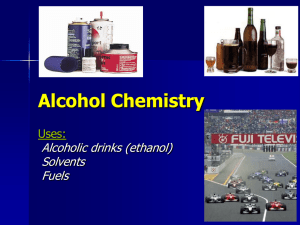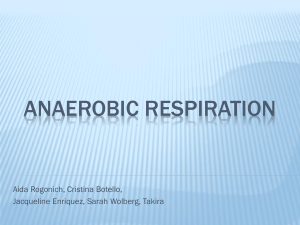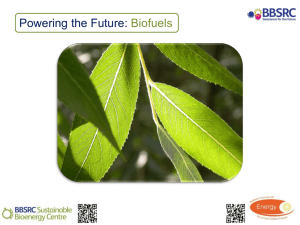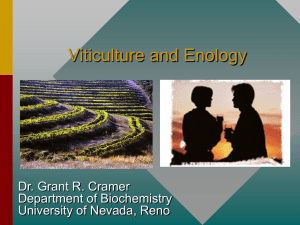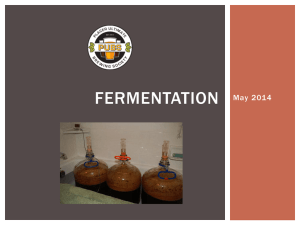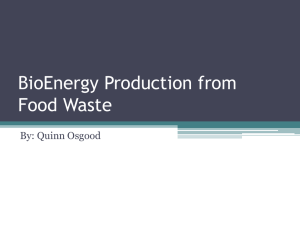Role of Genetic Engineering in Fermentation Technology
advertisement
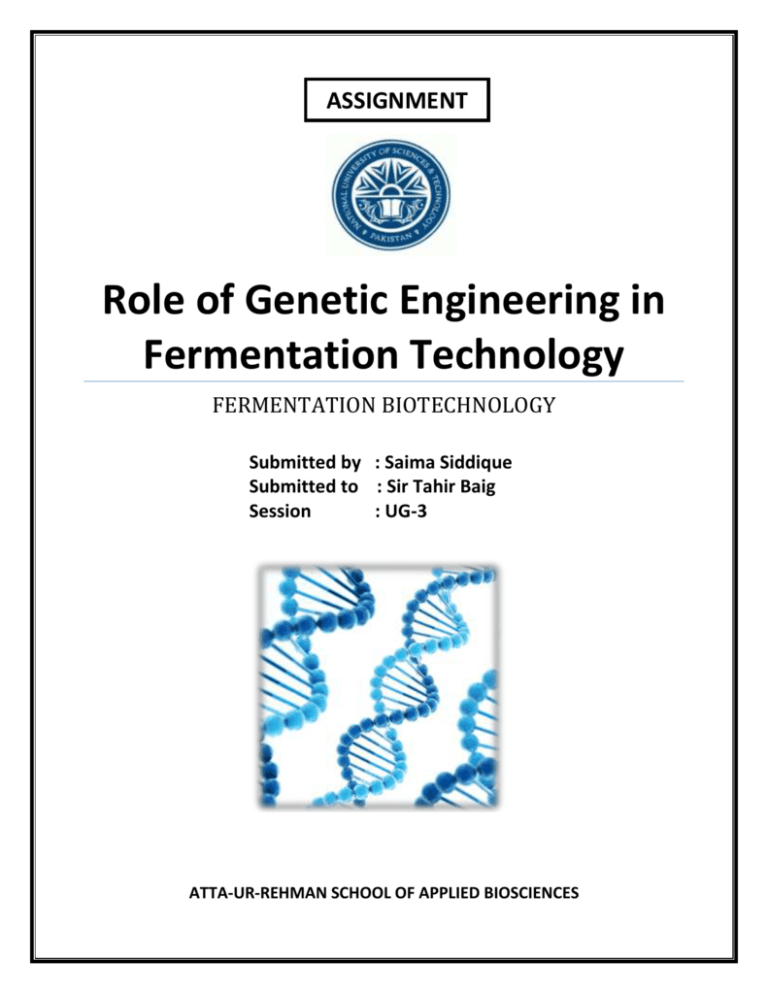
ASSIGNMENT Role of Genetic Engineering in Fermentation Technology FERMENTATION BIOTECHNOLOGY Submitted by : Saima Siddique Submitted to : Sir Tahir Baig Session : UG-3 ATTA-UR-REHMAN SCHOOL OF APPLIED BIOSCIENCES INTRODUCTION Biotechnology is the application of scientific and engineering principles to the processing of different materials with biological agents to provide goods and services. Essentially, biotechnology harnesses the catalytic power of biological systems, whether by direct use of enzymes or through the use of the intricate biochemistry of whole cells and micro-organisms. Biotechnology involves the use in industry of living organisms or their components i.e. enzyme. It includes the introduction of genetically engineered micro-organisms into a variety of industrial processes. Because nearly all the products of biotechnology are manufactured by micro-organisms, fermentation is an indispensable element of biotechnology’s support system. Defined in this way, biotechnology encompasses everything from the technology of bread-making to that implicated in the manufacture of human insulin from a bacterium induced to take up a non-bacterial gene and produce the protein coded by that gene. The potential of biotechnology for increasing agricultural productivity is high, in terms of both increasing the yields of cultivated plants and of obtaining foodstuffs with higher nutritional value. Numerous foodstuffs are manufactured using fermentation, and enzymes are now widely used as processing aids in food manufacturing. Acetone, citric acid, ethanol, and other chemicals are, or have been, produced industrially by fermentation. FERMENTATION For centuries natural fermentation processes have been used to produce products including cheese, yoghurt and beer. On the other hand, since the birth of genetic engineering (1970s), genes have been spliced between different types of micro-organims in order to enable the production of products using transgenic E.coli bacterium and other micro-organisms. At present, transgenic E.coli bacterium are used in production of almost all manner of things including chymosin (as required in the making of cheese), as well as human growth hormones, synthetic insulin and first generation bioplastics and biofuels. Over the years, the scope and efficiency of the fermentation process has been gradually improved and refined. Two processes now exist, both of which will benefit from genetic engineering. In fermentation technology, living organisms provide miniature factories, converting raw materials into end products. In enzyme technology, biological catalysts take from living organisms are utilized to make the products. FERMENTATION INDUSTRIES The food processing, chemical, and pharmaceutical industries are the three major users of fermentation today. The food industry was the first one to exploit micro-organisms to produce alcoholic beverages and fermented foods. In the early 20th century, the chemical industry began to use the technology to produce organic solvents like ethanol, and enzymes like amylase, used at the time to treat textiles. About thirty years later after the World War II, the pharmaceutical industry followed the chemical industry’s lead, applying fermentation to the production of vitamins and new antibiotics. Today, approximately 200 companies in the United States and over 500 worldwide use fermentation technologies to produce a wide variety of products. Most use them as part of production processes, usually in food processing. But others manufacture either proteins, which can be considered primary products, or a host of secondary products, which these proteins help produce. For genes can make enzymes, which are proteins; and the enzymes can help make alcohol, methane, antibiotics, and many other substances. Fermentation technologies are so useful for producing proteins partly because these are the direct products of genes. But proteins in the form of enzymes can also be used in thousands of additional conversions to produce practically any organic chemical and many inorganic ones as well. FERMENTATION USING WHOLE LIVING CELLS Originally, fermentation used some of the most primitive forms of plant life as cell factories e.g. Bacteria were used to make yogurt and antibiotics Yeasts to ferment wine The filamentous fungi or molds to produce organic acids More recently, fermentation technology has begun to use cells derived from higher plants and animals under growth conditions known as cell or tissue culture. In all cases, large quantities of cells with uniform characteristics are grown under defined, controlled conditions. COMPARATIVE ADVANTAGES OF FERMENTATIONS USING WHOLE CELLS AND ISOLATED ENZYMES At present, it is still uncertain whether the use of whole cells or isolated enzymes will be more useful in the long run. There are advantages and disadvantages to each. With isolated enzymes, genetic manipulation can readily increase the supply of enzymes, while with whole organisms, a wide variety of manipulations is possible in constructing more productive strains. THE PROCESS OF ENZYME TECHNOLOGY Although live yeast had been used for several thousand years in the production of fermented foods and beverages, it was not until 1878 that the active agents of the fermentation process were given the name “enzymes” (from the Greek, meaning “in yeast”). The inanimate nature of enzymes was demonstrated less than two decades later when it was shown that extracts from yeast cells could effect the conversion of glucose to ethanol. Finally, their actual chemical nature was established in 1926 with the purification and crystallization of the enzyme urease. Fermentation carried out by live cells provided the conceptual basis for designing fermentation processes based on isolated enzymes. A single enzyme situated within a living cell is needed to convert a raw material into a product. A lactose-fermenting organism, e.g., can be used to convert the sugar lactose, which is found in milk, to glucose (and galactose). But if the actual enzyme responsible for the conversion is identified, it can be extracted from the cell and used in place of a living cell. The purified enzyme carries out the same conversion as the cell, breaking down the raw material in the absence of any viable micro-organism. An enzyme that acts inside a cell to convert a raw material to a product can also do this outside of the cell. THE RELATIONSHIP OF GENETICS TO FERMENTATION Applied genetics is intimately tied to fermentation technology, since finding a suitable species of microorganism is usually the first step in developing a fermentation technique. Until recently, geneticists have had to search for an organism that already produced the needed product. However, through genetic manipulation a totally new capability can be engineered; micro-organisms can be made to produce substances beyond their natural capacities. The most striking successes have been in the pharmaceutical industry, where human genes have been transferred to bacteria to produce insulin, growth hormone, interferon, thymosin a-1, and somatostatin, In general, once a species is found, conventional methods have been used to induce mutations that can produce even more of the desired compound. The geneticist searches from among hundreds of mutants for the one micro-organism that produces most efficiently. The current industrial approach to fermentation technologies therefore considers two problems: First, whether a biological process car produce a particular product Second, which micro-organism has the greatest potential for production and how the desired characteristic can be engineered for it. Finding the desired micro-organism and improving its capability is so fundamental to the fermentation industry that geneticists have become important members of fermentation research teams. Genetic engineering can increase an organism’s productive capability (a change that can make a process economically competitive) but it can also be used to construct strains with characteristics other than higher productivity. Properties such as objectionable color, odor, or slime can be removed. The formation of spores that could lead to airborne spread of the microorganism can be suppressed. The formation of harmful byproducts can be eliminated or reduced. Other properties, such as resistance to bacterial viruses and increased genetic stability, can be given to micro-organisms that lack them. Applying recent genetic engineering techniques to the production of industrially valuable enzymes may also prove useful in the future. GENETIC ENGINEERING AND FERMENTATION INDUSTRY Genetic engineering is not in itself an industry, but a technology used at the laboratory level. It allows the researcher to alter the hereditary apparatus of a living cell so that the cell can produce more or different chemicals, or perform completely new functions. The altered cell, or more appropriately the population of altered identical cells is, in turn, used in industrial production. It is within this framework that the impacts of applied genetics in the various industries is examined. Regardless of the industry, the same three criteria must be met before genetic technologies can become commercially feasible. They include the need for: 1. a useful biochemical product; 2. a useful biological fermentation approach to commercial production; and 3. a useful genetic approach to increase the efficiency of production. The three criteria interrelate and can be met in any order; the demonstration of usefulness can begin with any of the three. Insulin, e.g., was first found to have value in therapy; fermentation was then shown to be useful in its production; and, now genetic engineering promises to make the fermentation process economically competitive. In contrast, the value of thymosin a-1, has not yet been proved, although the usefulness of genetic engineering and fermentation in its production have been demonstrated. STRAIN IMPROVEMENT FOR ENGINEERING TECHNOLOGY BIOCATALYSIS PROCESSES AND FERMENTATION BY GENETIC In the past, enzyme engineering required the prior knowledge of the 3-D structure of the enzyme before any rational design of mutation could be carried out. Twenty years ago, the first complete gene cluster encoding the actinorhodin biosynthetic pathway was cloned and characterized. Afterwards, the gene clusters encoding the biosynthetic pathways for many antibiotics were isolated. In the past decade, breakthroughs in technology brought that generation of rationally designed or new hybrid metabolites to completion. Now, the development of high-throughput DNA sequencing and DNA microarray techniques enables researchers to identify the regulatory mechanisms for the overproduction of secondary metabolites and to monitor gene expression during the fermentation cycle, accelerating the rational application of metabolic pathway engineering. The use of whole cells or partially purified enzymes as catalysts has been increased significantly for chemical synthesis in pharmaceutical and fine-chemical industries. The development of PCR technologies for protein engineering and DNA shuffling is leading to the generation of new enzymes with Increased stability to a wide range of pHs, temperatures and solvents Increased substrate specificity, reaction rate and enantioselectivity . Using genetic engineering techniques, the objectives for enzyme engineering have been mostly achieved. THE POTENTIAL OF GENETIC ENGINEERING FOR IMPROVING BREWING, WINE-MAKING AND BAKING YEASTS Yeasts have been used to produce food and beverages since the Neolithic age. Their use in fermentation was recognized in 1836–1838; and Louis Pasteur demonstrated their unequivocal role in the conversion of sugar to ethanol and carbon dioxide in 1861. Originally, fermentation was spontaneous. The first pure yeast culture was obtained by Emil Christian Hansen from the Carlsberg Brewery in 1883. A pure culture of wine yeast was subsequently obtained by Müller-Thurgau from Geisenheim (Germany) in 1890. The genetic improvement of industrial strains traditionally relied on classical genetic techniques (mutagenesis, hybridization, protoplast fusion, cytoduction), followed by selection for broad traits such as fermentation capacity, ethanol tolerance, absence of off-flavors (e.g. H2S for wine strains), fast dough fermentation, osmotolerance, rehydration tolerance, organic acid resistance (baker’s strains), flocculation and carbohydrate utilization (brewer’s strains). One major advantage of gene technology over classical genetic techniques is that just one characteristic can be precisely modified, without affecting other desirable properties. In addition, molecular biology approaches have introduced a new dimension. The expression of heterologous genes has substantially increased the possibilities. In the past 20 years, impressive progress has been made in the development of molecular techniques for Saccharomyces cerevisiae. These advances have been successfully applied to industrial strains in the past decade, allowing the development of a new generation of specialized industrial yeast strains. The principal targets for strain development fall into two broad categories: (1) improvement of fermentation performance and simplification of the process and (2) improvement of product quality, e.g. organoleptic and hygienic characteristics. GENETIC ENGINEERING FOR IMPROVED XYLOSE FERMENTATION BY YEASTS A few yeasts are known to ferment xylose directly to ethanol. However, the rates and yields need to be improved for commercialization. Xylose utilization is repressed by glucose which is usually present in lignocellulosic hydrolysates, so glucose regulation should be altered in order to maximize xylose conversion. Xylose utilization also requires low amounts of oxygen for optimal production. Respiration can reduce ethanol yields, so the role of oxygen must be better understood and respiration must be reduced in order to improve ethanol production. This is being made possible by using genetic engineering. Xylose is the second most abundant carbohydrate in the lignocellulosic biomass hydrolysate. The fermentation of xylose is essential for the bioconversion of lignocelluloses to fuels and chemicals. A few yeasts are known to ferment xylose directly to ethanol. However, the rates and yields need to be improved for commercialization. Wild-type strains of Saccharomyces cerevisiae are unable to utilize xylose. A modified genome shuffling method were developed to improve xylose fermentation by S. cerevisiae. Recombinant yeast strains were constructed by recursive DNA shuffling with the recombination of entire genome of P. stipitis with that of S. cerevisiae. After two rounds of genome shuffling and screening, one potential recombinant yeast strain ScF2 was obtained. It was able to utilize high concentration of xylose and produced ethanol. The recombinant yeast ScF2 produced ethanol more rapidly than the naturally occurring xylose-fermenting yeast. REFERENCES 1. 2. 3. 4. 5. 6. 7. 8. 9. http://www.explainingthefuture.com/genetics.html http://archive.unu.edu/unupress/unupbooks/uu09ue/uu09ue17.htm http://www.biotechnologyforbiofuels.com/content/pdf/1754-6834-5-46.pdf http://www.princeton.edu/~ota/disk3/1981/8115/811505.PDF OTA (Office of Technology Assessment). Commercial Biotechnology: An International Analysis. OTA-BA-218. January. Washington, D.C.: Government Printing Office. 1984 “Strain improvement for fermentation and biocatalysis processes by genetic engineering technology”: Shu-Jen Chiang , Society for Industrial Microbiology. (http://link.springer.com/content/pdf/10.1007%2Fs10295-004-0131-z) “The potential of genetic engineering for improving brewing, wine-making and baking yeasts”:S.Dequin, : 19 April 2001 / Accepted: 20 April 2001 / Published online: 15 June 2001 © Springer-Verlag 2001 (http://bio.ijs.si/~upetrovic/png/GM_yeast_wine_making_brewing_baking_AEM_56_577.pdf ) “Ethanol fermentation from biomass resources: current state and prospects”: Yan Lin . Shuzo Tanaka (http://awe.mol.uj.edu.pl/~allel/s6/pliki/mbPrz_seminaria/ethanol.pdf) “Genetic engineering for improved xylose fermentation by yeasts”: Jeffries TW, Shi NQ. USDA, Forest Service, Institute for Microbial and Biochemical Technology, Madison, WI 53705, USA. (http://www.ncbi.nlm.nih.gov/pubmed/10533434)

